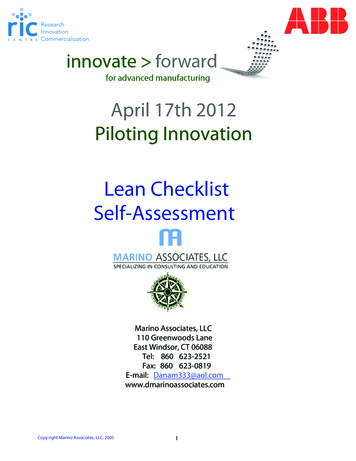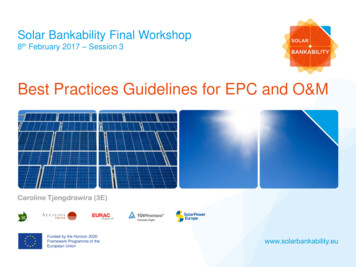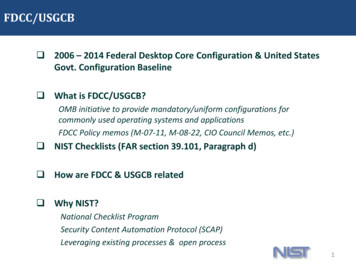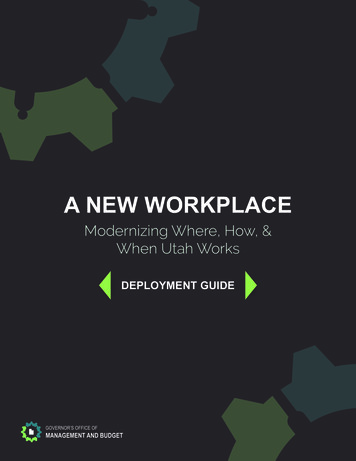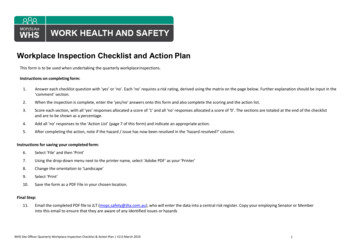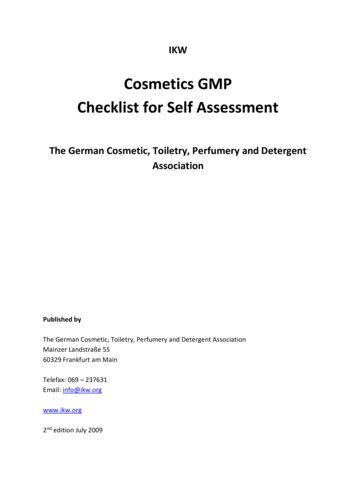
Transcription
Workplace EnvironmentSelf-Assessment Checklistworkplacesafetynorth.ca
Workplace Environment Self-Assessment ChecklistWorkplace EnvironmentSelf-Assessment Checklist
Workplace Environment Self-Assessment ChecklistWorkplace Safety North (WSN) is the health and safety association serving underground and surfacemines, tunneling, smelters, refineries and related sectors in Ontario. We provide auditing andconsulting services, training and information to help our member companies meet our shared vision ofan industry where every worker comes home safe and healthy, every day.The information contained in this manual is for general educational and informative purposes only.WSN makes no representation, express or implied, with regard to the accuracy, reliability orcompleteness of this information, and cannot accept any legal responsibility or liability for any errorsor omissions.All rights reserved. No part of this publication may be reproduced, stored in an electronic database ortransmitted in any form by any means, electronic, photocopying, recording or otherwise without priorwritten permission of WSN.P.O. Box 2050, Stn. Main,690 McKeown Avenue, NorthBay, Ontario, Canada P1B 9P11 888 730 7821 (Ontario only)705 474 7233workplacesafetynorth.caWSN 2015
Workplace Environment Self-Assessment ChecklistTable of ContentsFOREWORD .iii1. PHYSICAL HAZARDS . 11.1 NOISE . 11.2 IONIZING RADIATION . 61.3 RADON . 101.4 NON-IONIZING RADIATION . 131.5 HEAT STRESS . 141.6 COLD ENVIRONMENTS . 171.7 VIBRATION . 201.8 MUSCULOSKELETAL DISORDERS (MSDs) . 232. BIOLOGICAL HAZARDS. 272.1 BIOLOGICAL AGENTS . 272.2 BACTERIA, VIRUSES AND FUNGI . 303. CHEMICAL HAZARDS . 333.1 CHEMICAL AGENTS INCLUDING MINE GASES . 333.2 SPECIFIC EXAMPLES FOR CHEMICAL AGENTS . 373.2.1 Styrene . 373.2.2 Welding Fumes . 403.2.3 Chromium (VI) . 443.3 DESIGNATED SUBSTANCES. 473.4 DIESEL PARTICULATE MATTER . 514. AUXILIARY MINE VENTILATION . 545. WORKING ON SURFACE AND WILDLIFE HAZARDS . 605.1 WEST NILE VIRUS (WNV) . 605.2 TICK BITES AND LYME DISEASE. 626. WHMIS 2015 . 64ii
Workplace Environment Self-Assessment ChecklistFOREWORDOccupational health is a growing concern in the mining industry and WSN would like to thankthe Workplace Environment Committee for initiating a review and update of the WorkplaceEnvironment Checklist.The checklist is designed to capture a point-in-time picture of industrial hygiene programs at aworksite. It can be used by supervisors, Joint Health and Safety Committees or health and safetydepartments. The checklist can be used anytime, but it is recommended to revisit the checklist ifa new operation sets up or significant changes occur in operations or procedures.The document is divided into categories based on common worksite health hazards. Referencesto legislation and work practices are provided within the checklist. If you have any questionsregarding programs or legislation, feel free to contact a WSN Health and Safety Specialist formore information.WSN’s third edition of the Workplace Environment Checklist represents current revisions on thesubject of workplace environment worksheets. It is a valuable reference for those who desire toimprove the health and safety of their workplace. WSN would like to thank the contributions ofprevious members of WSN’s Workplace Environment Technical Advisory Committee, and tocurrent committee members in making this new edition possible.1. Workplace Environment Committee members (as of December 31, 2014):Lise Sauvé-Gingras (Chair)Anthony Chevrier (Vice-Chair)Jason ChevrierBrian MaeckJudit NelsonLaura MucklowJamie Cresswell (Technical Advisor)Euler De Souza (Technical Advisor)Alison Godwin (Technical Advisor)Stephen Hardcastle (Technical Advisor)Philip Dirige (Coordinator)Glencore - Sudbury Integrated Nickel OperationsVale - North Atlantic Base Metals Ontario OperationsKGHM International Ltd. - Sudbury Operations,Boart Longyear Canada - Eastern ZoneFirst Nickel Inc. - Lockerby MineGlencore - Sudbury Smelter OperationsOntario Ministry of LabourQueen’s University - The Robert M. Buchan Departmentof MiningLaurentian UniversityCANMET Mining - SudburyWorkplace Safety Northiii
Workplace Environment Self-Assessment Checklist1. PHYSICAL HAZARDS1.1 NOISECOMPANYSITE/OPERATION1. Has a noise survey been conducted to assess the likelihood ofworker exposure to high noise levels?1(a) - As a rule of thumb, a noise survey should include all work areas where it isdifficult to communicate at a normal speech level within a distance of one metre.2. Were all noise levels measured in the survey below 85 dBA?YES NO If no, see box 1(a)YES NO If yes, go to question 4.3. List the locations where noise levels exceeded 85 dBA.LOCATIONRANGE (dBA)AVG. (dBA)A “Noise Map” of the plant will be useful to quickly identify the areas with the highest noise levels. Amore detailed survey of the areas showing high noise levels should be conducted.1
Workplace Environment Self-Assessment Checklist4. Has any monitoring been conducted to evaluate the Lex,8 of theworkers by occupation? The term “Lex,8” refers to the eighthour equivalent of noise exposure experienced by the worker.4(a) - A program should be in place to assess the Lex,8 of all job tasks. This maybe accomplished either with the use of an approved noise dosimeter or bylogging the individual’s movements and calculating his/her exposure based onlength of time spent in each area.5. Did the monitoring indicate that workers would not experiencea Lex,8 noise exposure in excess of 85 dBA?YES NO If no, see box 4(a)If work shift is longer thaneight hours ( Lex,8), go toquestion 7.YES NO If yes, stop here5(a) - Section 293.1 (6) of Regulation 854 states that workers must not beexposed to sound levels greater than an equivalent of 85 dBA for eight-hour workshift, (Lex,8).If no, see box 5(a)For work shift longer than 8 hours (e.g., 10 hrs, 10.5 hrs or 12 hrs), the exposurelimit should be pro-rated.6. List the Lex,8 noise exposures measured for each occupation:OCCUPATION*C - calculatedRANGE (dBA)AVG. (dBA)MEASUREMENT (C/D)*D - dosimetry7. Has any monitoring been conducted to evaluate the weightedexposure levels of workers for extended work shifts ( Lex,8 ) (i.e.10, 10.5, 12-hr shifts)?7(a) - A program should be in place to assess the exposure levels of workers forextended work shifts of all job tasks. This may be accomplished either with theuse of an approved noise dosimeter or by logging the individual’s movementsand calculating his/her exposure based on length of time spent in each area.2YES NOIf no, see box 7(a)
Workplace Environment Self-Assessment Checklist 8. Did the monitoring indicate that workers would not experienceYESNOhigher dBA exposures than the adjusted dBA levels based on theIf yes, stop hereextended work shift?8(a) - Workers must not be exposed to sound levels greater than the equivalentadjusted dBA determined for the extended work shift. For work shifts longer thaneight hours, weighted exposure levels should be adjusted based on the extendedwork shifts time. If no, see box 8(a)Weighted exposure levels for extended work shifts can be adjusted using theequations:Daily adjustment formula:𝐴𝑑𝑗𝑢𝑠𝑡𝑒𝑑 𝑇ℎ𝑟𝑒𝑠ℎ𝑜𝑙𝑑 𝐿𝑒𝑣𝑒𝑙 𝑉𝑎𝑙𝑢𝑒 (𝑇𝐿𝑉) 8 ℎ𝑟 𝑇𝑊𝐴 𝑥8ℎWhere, h is the number of hours worked per dayWeekly adjustment formula:𝐴𝑑𝑗𝑢𝑠𝑡𝑒𝑑 𝑇ℎ𝑟𝑒𝑠ℎ𝑜𝑙𝑑 𝐿𝑒𝑣𝑒𝑙 𝑉𝑎𝑙𝑢𝑒 (𝑇𝐿𝑉) 8 ℎ𝑟 𝑇𝑊𝐴 𝑥40ℎWhere, h is the number of hours worked per week9. List the extended work shift noise exposures measured for each occupation:OCCUPATION*C - calculatedRANGE (dBA)AVG. (dBA)D - dosimetry3MEASUREMENT (C/D)*
Workplace Environment Self-Assessment Checklist10. Has a written hearing conservation program been preparedfor this plant or operation?10(a) - A written hearing conservation program should be prepared andimplemented. The program should address noise measurement, engineeringand administrative controls, personal hearing protection and audiometry.YES NO If no, see box 10(a)Resource: Establishing a Noise Control Program in the Workplace, WSIB.11. Have all protective measures reasonably necessary in thecircumstances to protect workers from exposure to hazardoussound levels been carried out, including the provision and useof engineering controls and work practices?YES NO If no, see box 11(a) 11(a) - Section 293.1 (3) of Regulation 854 states that every employer shalltake all measures reasonably necessary in the circumstances to protect workersfrom exposure to hazardous sound levels, and (4) states that protectivemeasures shall include the provision and use of engineering controls, workpractices and, subject to subsection (7), personal protective equipment.12. Is personal hearing protection made available to all employeeswho are at risk of exposure to Lex,8 noise levels in excess of 85dBA or to noise levels in excess of the adjusted TLV forextended work shifts?12(a) - Ensure that the rated and actual attenuation of the protective equipmentis adequate for the maximum levels of noise encountered as defined by yourcompany’s policy and procedures.12(b) - Ensure that appropriate hearing protection is made available to allemployees who require it. Note: Double hearing protection should be wornwhen noise levels exceed 105 dBA.13. Are workers aware of ototoxic chemicals in the workplace, andhow to take precautions when working with or near ototoxicchemicals?13(a) - Workers must be aware of workplace hazards. Ototoxic chemicals suchas styrene, toluene, xylene, carbon monoxide, lead and manganese are known tobe toxic to the organs of the ear.4YES NO If yes, see box 12(a)If no, see box 12(b)YES NO If no, see box 10(a)
Workplace Environment Self-Assessment Checklist14. Are all entrances or equipment with high noise levels (i.e. 85dBA) posted with suitable signs stating the noise level andreminding employees of the type of hearing protection (single ordouble) that is required?14(a) - A clearly visible warning sign must be posted at every approach to a highnoise area. Employees should be trained in the proper use of personal protectiveequipment.15. Are employees who are exposed to noise hazards at thissite/ operation included in an established audiometryprogram?15(a) - An audiometry program, including provisions for pre-employment andperiodic audiometric testing and evaluation should be in place.YES NO If no, see box 11(a)YES NO If no, see box 12(a)Checklist completed by:NAMETITLEDATEReferences:Regulation 854 (Mines and Mining Plants), Section 293.1, as amended by Ontario Regulation34/14, R.R.O. 1990Health and Safety Ontario - Hearing Conservation, Workplace Safety and Prevention Services(WSPS)Ontario Occupational Health and Safety Act (OHSA) R.R.O 1980Establishing a Noise Control Program in the Workplace, Workplace Safety and Insurance Board5
Workplace Environment Self-Assessment Checklist1.2 IONIZING RADIATIONCOMPANYSITE/OPERATION1. Does the site/operation have any equipment which emits ionizingradiation? This may include units such as gamma density or level YESNOgauges, x-ray fluorescence analyzers, industrial radiographyIf no, stop here.equipment (such as bin measurement devices), equipment usedto check welding work, static eliminators, soil testers, etc. 2. List all equipment that emits ionizing radiation:EQUIPMENT TYPEUSELOCATION3. Does any of the equipment listed in (2) contain a radioisotope?Note: Equipment containing a radioactive isotope of an element is federallyregulated, while x-ray equipment is provincially regulated.YES NO If no, go to question 104. Is a Radioisotope License required under the Nuclear Safety andControl Act, for the equipment listed in (2)?YES NO If no, go to question 106
Workplace Environment Self-Assessment Checklist5. List the Radioisotope licenses applicable to this site/operation:LICENCE NUMBER/RENEWAL DATEDESCRIPTION/APPLICATION6. Is a copy of each license posted in a conspicuous location?YES6(a) - Required under the Nuclear Safety and Control Act. NO If no, see box 6(a)7. Is a current inventory of all equipment containing radioisotopes(in quantities requiring licensing) available?7(a) - Part of the records required under the Nuclear Safety and Control Act.YES NO If no, see box 7(a).8. Are leak tests performed on each sealed unit, at a frequencyspecified in the conditions of the license(s)?8(a) - Requirement for maintenance of license.YES NO If no, see box 8(a)9. Are clearly visible and legible signs, providing the name andnumber of a contact person or department, located on, ornear, all devices containing radioactive prescribed substances?YES NO If no, see box 9(a)9(a) - Requirement for maintenance of license.10. Are x-ray machines present or used at this site?YES NO If no, go to question 1611. Is the employer who has possession of the x-ray source registeredwith the Director of the Special Studies and Services Branch ofYESthe Ontario Ministry of Labour (MOL)? NO If no, see box 11(a)11(a) - Regulatory requirement.7
Workplace Environment Self-Assessment Checklist12. Is a current inventory of all x-ray sources at the site/operationavailable?12(a) - Having an inventory of all x-ray sources is required by law.YES NO If no, see box 12(a).13. Are all areas, rooms, or enclosures where x-ray equipment isused, or where radioactive isotopes are present appropriatelymarked with durable signs?YES NO If no, see box 13(a)13(a) - Refer to the applicable regulations.14. Are the risk of atomic radiation and/or x-ray workers exposureassessed based on the radiation sources in the workplace andbased on the risk of exceeding the effective/equivalent doselimits set-out by the Canadian Nuclear Safety Commission(CNSC)?YES NO If no, see box 14(a)14(a) - This is a regulatory requirement, consult appropriate regulation(s).15. Are all atomic radiation workers and/or x-ray workers providedwith suitable personal dosimeters to provide an accuratemeasure of the dose equivalent received by the worker?YES NO If no, see box 15(a)15(a) - This is a regulatory requirement, consult appropriate regulation(s).16. Is a management system in place to address the personaldosimetry (e.g. Worker notification of results, recordretention, etc.)?YES NO If no, see box 16(a)16(a) - This is a regulatory requirement, consult appropriate regulation(s).17. Are written training programs in place for atomic radiationworkers and/or x-ray workers?YES NO If no, see box 17(a)17(a) - This is a regulatory requirement, consult appropriate regulation(s).Training should be provided to all workers working near or with radiation sources.8
Workplace Environment Self-Assessment ChecklistChecklist completed by:NAMETITLEDATEReferences:FEDERALNuclear Safety and Control Act (NSC Act) 2000Canadian Nuclear Safety Commission (CNSC).Transport Packaging of Radioactive Materials RegulationsONTARIORegulations for Mines and Mining Plants, R.R.O. 1990, Reg. 854, Sections 288-293 Regulations RespectingX-Ray Safety R.R.O 1990, Regulation 8619
Workplace Environment Self-Assessment Checklist1.3 RADON (Underground Mining Only)COMPANYSITE/OPERATION1. Has your worksite been tested for radon progeny by a competentperson?YES1(a) - This is required by Section 289 (4) of Regulation 854 (Mines and MiningPlants).2. Is additional radon progeny sampling done whenever: (a) amine is reopened; (b) within six months after thecommencement of a new mine; (c) an inflow of water isestablished or (d) a breakthrough of active workings occursinto an abandoned, inactive or active mining area?2(a) - Sampling whenever a mine is opened and within six months of excavation isrequired by law under Section 289 (2) of Regulation 854. It is recommended tocomplete additional testing for breakthroughs and new inflows of water.3. Does the Joint Health and Safety Committee have a copy of theradon progeny test results3(a) - This is required by law under Section 289 (5) of Regulation 854.4. Are the results of all testing posted in a conspicuous place forat least 14 days for workers to see?4(a) - This is required by law under Section 289(5) of Regulation 854.YES NO If no, see box 2(a)YES NO If no, see box 3(a)YES NO If no, see box 4(a)YES10NOIf no, see box 1(a)5. Are results of the testing kept on file by the company?5(a) - This is required by law under Section 289(6) of Regulation 854. NOIf no, see box 5(a)
Workplace Environment Self-Assessment Checklist6. From the site sampling, was the concentration of radon progeny in any area: less than 0.03 WL? If yes, go to question 13.Between 0.03 - 0.06 WL? If yes, go to question 10Between 0.061 - 0.10 WL? If yes, go to question 9Greater than 0.10 WL? If yes, go to question 7NOTE: If a concentration of greater than 0.33 WL is recorded the mine must immediately remove all workers fromthe affected area (Section 291 of Regulation 854) and implement the measures and procedures required by Section255 (1)of Regulation 854.7. Is the workplace retested for radon progeny at least once amonth?7(a) - This is required by Section 289(3)(a) of Regulation 854.8. Have written descriptions of work practices been developed withthe JHSC (or health and safety rep) for areas with radonprogeny greater than 0.10 WL?8(a) - This is recommended by WSN, proceed to question 10.9. Is the workplace sampled for radon progeny at least every threemonths?9(a) - This is required by Section 289(3)(b)of Regulation 854.10. Is corrective action taken to reduce levels (if possible) and is thearea resampled after corrections are made?10(a) - Resampling is recommended to ensure corrective actions were effective.11. Are locations with potential worker exposure to radon gasclearly identified?YES NO If no, see box 7(a)YES NO If no, see box 8(a)If yes, go to question 10YES NO If no, see box 9(a)YES NO If no, see box 10(a)YES NO If no, see box 11(a)11(a) - This is required by law.11
Workplace Environment Self-Assessment Checklist12. Is worker exposure to areas with radon gas limited?YES12(a) - Ministry of Labour (MOL) guidelines outline the radon levels that workerscan be exposed to.13. Does a competent person assess at least once a year whether toretest the air for radon progeny by taking into account previoustest results and changes in the mine and mining operations? Isthis done in consultation with the JHSC? NO If yes, see box 12(a)YES NO If yes, see box 13(a)13(a) - This is required by Section 289(4)of Regulation 854.Checklist completed by:NAMETITLEDATEReferencesMines and Mining Plants, R.R.O 1990 Regulation 854, Section 287-293 Regulation 583/91,5812
Workplace Environment Self-Assessment Checklist1.4 NON-IONIZING RADIATIONCOMPANYSITE/OPERATION1. Have all possible sources of non-ionizing radiation such asultraviolet radiation (including exposure to sun, tanning beds,black lights, etc.), visible (white light) radiation, infraredradiation, and electromagnetic fields (EMFs) radiations(including microwave, radio waves, radar, radiation producedby electric transmission, wired and wireless electronicequipment, etc.) been identified?YES NO If no, see box 1(a).1(a) - Required by the Occupation Health and Safety Act (OHSA).2. Have sources of non-ionizing radiation been evaluated bya competent person?2(a) - Required by the Occupation Health and Safety Act (OHSA).3. Have workers been aware of the hazards of non-ionizingradiation and how to protect themselves? Are trainingrecords kept and stored by the company?YES NO If no, see box 2(a).YES NO If no, see box 3(a).3(a) - Required by the Occupation Health and Safety Act (OHSA).4. Are workers with medical conditions that may be affected byionizing radiation (pacemakers, metallic implants) identifiedand evaluated? Is their exposure monitored?YES NO If no, see box 4(a).4(a) - Required by the Occupation Health and Safety Act (OHSA).Checklist completed by:NAMETITLEDATEReferences:NIOSH, Non-Ionizing Radiation: Self-Inspection Checklist13
Workplace Environment Self-Assessment Checklist1.5 HEAT STRESSCOMPANYSITE/OPERATION1. Do employees encounter high temperature, humidity, radiantheat, or areas of low air flow while performing physical workactivity?YES2. Are workers required to work at a high metabolic rate?YES NO If no, stop here NO If no, see box 2(a)2(a) - Examples of metabolic rate categories.CategoriesExample activitiesSitting with moderate arm and leg movementsStanding, working with arms in light lifting, turningLightUsing small power toolsWalking slowly on level surface carrying minimal weightRapid and/or forceful arm movementsModerateWalking with moderate lifting or pushingWalking 6 km/hr on level surface carrying 3 kg loadHand sawing, Shoveling light materialHeavy whole body motionsHeavyIntermittent heavy lifting or working with hands above headWalking slowly up steep gradesShoveling heavy material, near continuous heavy liftingVery heavyWalking 6 km/hr up grades and/or carrying heavy load3. Are workers required to wear multiple layers of clothing orimpermeable clothing that may restrict heat loss?YES NO If no, see box 2(a)3(a) - Thermally insulating clothing, multiple layers of clothing andencapsulating suits severely restrict heat removal.4. Does your site or company have a program to manage heatstress?YES NOIf no, see box 2(a)4(a) - A heat stress response plan indicates when to post heat stress alertnotices, and specifies the amount of water and rest time that should be providedbased on the temperature. Humidity must be taken into account to gatheraccurate data regarding workplace temperature.14
Workplace Environment Self-Assessment Checklist5. Are workers trained in identifying signs of heat-related illnessand heat stress?YES NO If no, see box 5(a and b)5(a) - Workers should be trained to identify signs and symptoms of heatillnesses. Heat illnesses become progressively worse with more exposure.Recognizing signs and symptoms early can prevent more complicated heatillnesses such as heat stroke from developing.5(b) - The most common signs and symptoms of heat exhaustion include:Confusion, dark-colored urine (a sign of dehydration), dizziness, fainting,fatigue, headache, muscle or abdominal cramps, nausea, vomiting or diarrhea.6. Do you have a method to monitor heat exposure in yourworkplace?6(a) - The Occupational Health and Safety Council of Ontario has published aHeat Stress Prevention Guideline which provides information on how tomonitor heat exposure.7. Is a heat stress control plan (developed in consultation with theJHSC) in place to prevent workers from exposure to heatstress-related illness?7(a) - An effective heat stress control plan will prevent workers from sufferingheat-stress-related illnesses.YES NO If no, see box 6(a)YES NO If no, see box 7(a)Resource: Heat Stress - Ministry of Labour (MOL) Health and SafetyGuidelines.8. Does your company have a program for controlling workerexposure to heat-related illnesses such as hydration stations,self-regulation or co-worker observation to monitor for heatrelated illnesses?YES NOIf no, see box 8(a)8(a) - Employees should be provided with hydration breaks in high-risksituations and trained to be able to identify signs of heat stress withinthemselves. A co-worker observation system assigns workers to be responsiblefor each other. This is especially useful for heat illnesses as signs and symptomsare often easier for people to recognize in others then in themselves.15
Workplace Environment Self-Assessment ChecklistChecklist completed by:NAMETITLEDATEReferences:Beat the Heat: A Pocketbook Guide to Heat Stress and Strain, WSNHeat Stress Awareness Guideline, Occupational Health and Safety Council of Ontario, WSIB 2007Heat Stress - Ministry of Labour (MOL) Health and Safety Guidelines, 201416
Workplace Environment Self-Assessment Checklist1.6 COLD ENVIRONMENTSCOMPANYSITE/OPERATION1. Are workers exposed to cold environments while performingphysical work activity?YES NO If no, stop here2. Does your site or company have a program to manage coldstress?2(a) - A cold environment challenges the worker in three ways: by airtemperature, air movement (wind speed), and humidity (wetness). A program tocounterbalance these challenges and ensure workers work safely should bedeveloped, such as the use of work clothes with proper insulation (layeredprotective clothing), by doing physical activity and by controlling exposure tocold (work warm-up schedule).YES NO If no, see box 2(a)Resource: Cold Environments - Working in colds, Canadian Centre forOccupational Health and Safety (CCOHS).3. Are workers trained in identifying signs and symptoms ofillnesses associated with exposure to cold environments?3(a) - Workers should be trained to identify signs and symptoms of the effects ofexposure to cold environments. The effects of cold stress become progressivelyworse with more exposure. Recognizing signs and symptoms early can preventmore complicated illnesses associated with exposure to cold environments, suchas hypothermia or dangerous overcooling of the body, from developing.3(b) - Warning signs of hypothermia can include complaints of nausea, fatigue,dizziness, irritability or euphoria. Workers can also experience pain in theirextremities (hands, feet, ears, etc.), and severe shivering.Resource: the Canadian Centre for Occupational Health and Safety (CCOHS)Cold Environments - Working in cold, and the Ministry of Labour (MOL)Guideline No. 33: Working In Extreme Temperature Conditions / SafetyGuidelines for the Film and Television Industry in Ontario17YES NO If no, see box 3(a) and (b)
Workplace Environment Self-Assessment Checklist4. Do you have a method to monitor cold temperature exposure inyour workplace?4(a) - The Canadian Centre for Occupational Health and Safety (CCOHS)published on its website Cold Environments – Working in the Cold, whichprovides information on working in cold environment.YES NO If no, see box 4(a)The combined effect of cold air and wind speed is expressed as "equivalent chilltemperature" (ECT) or simply "wind chill" temperature in C or F. It isessentially the air temperature that would feel the same on exposed human fleshas the given combination of air temperature and wind speed. It can be used as ageneral guideline for deciding clothing requirements and the possible healtheffects of cold.In some parts of Canada the term "wind chill factor" is used. This is ameasurement of a heat loss rate caused by exposure to wind and it is expressedas the rate of energy loss per unit area of exposed skin per second (e.g.,joules/[second-metre2] or watts/metre2, W/m2).5. Is a cold stress prevention program (developed in consultationwith the JHSC) in place to prevent workers from exposure tocold related illnesses?5(a) - An effective cold stress prevention program will prevent workers fromsuffering cold related illnesses.YES NO If no, see box 5(a)Resource: the Ministry of Labour (MOL) Guideline No. 33: Working In ExtremeTemperature Conditions / Safety Guidelines for the Film and Television Industryin Ontario and the Canadian Centre for Occupational Health and Safety(CCOHS) Cold Environments – Working in the Coldcold.6. Does your company have a program for controlling workerexposure to cold-related illnesses, such as the use of protectiveclothing and work/rest schedule?6(a) - The Ministry of Labour (MOL) published on its website Guideline No. 33:Working In Extreme Temperature Conditions / Safety Guidelines for the Film andTelevision Industry in Ontario items to be considered in a cold stress preventionprogram.The Canadian Centre for Occupational Health and Safety (CCOHS) published onits website a Wind Chill Chart, which was adapted from American Conference ofGovernmental Industrial Hygienists (ACGIH) Threshold Limit Values (TLVs )and Biological Exposure Indices (BEIs ) that can be used as a general guidelinefor deciding clothing requirements and the possible health effects of cold.The "work warm-up schedule" developed by the Saskatchewan Department ofLabour can be used for work/rest sche
The checklist is designed to capture a point-in-time picture of industrial hygiene programs at a worksite. It can be used by supervisors, Joint Health and Safety Committees or health and safety . Establishing a Noise Control Program in the Workplace, Workplace Safety and Insurance Board . Workplace Environment Self-Assessment Checklist 6 1.2 .
